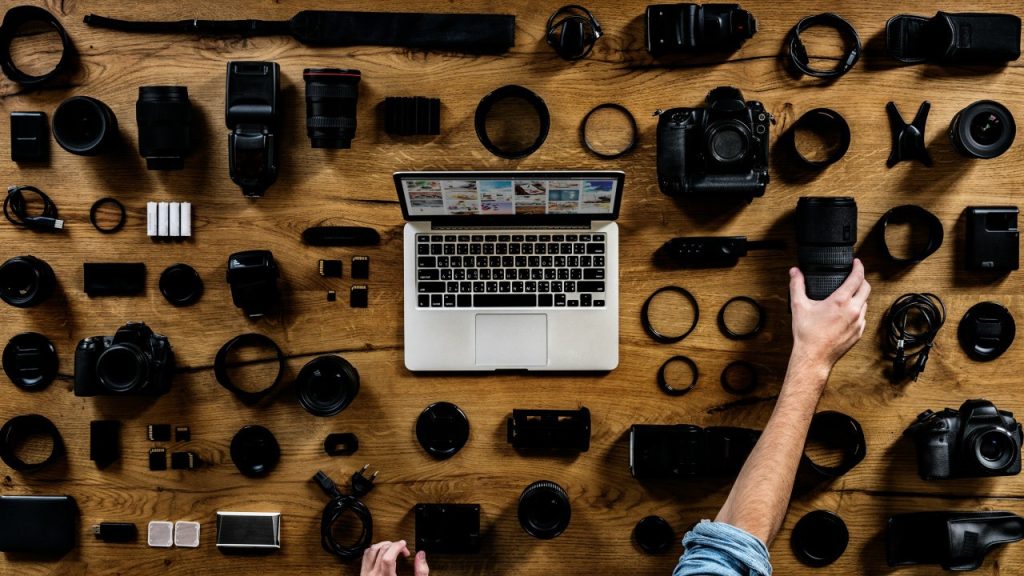Dealing With GAS: Gear Acquisition Syndrome

Creative business tips to kickstart your career as an artist, designer, or content creator.
Gear Acquisition Syndrome, commonly known as GAS, is a condition that an estimated 1 in 4 creatives will experience in their lifetime. Those living with the condition suffer from loss of time, crippled wallets, and an overall sense of dissatisfaction.
If you’ve heard the term “retail therapy” before, then you’re already familiar. GAS is the arguably more dangerous variant that affects creatives. While it can be hard to justify spending $1000 on shoes, when that $1000 is spent on tools or gear related to your career, it feels justified, productive even, which is exactly what makes it so dangerous.
GAS is known to affect all types of creatives and hobbyists, ranging from photographers and musicians to cyclists and illustrators. Essentially any undertaking involving tools with varying degrees of performance is fair game. Once GAS has taken root, its effects are far-reaching and can extend into every other area of life. Before you know it you’ve spent the better part of a Saturday researching mechanical pencil technology when you only meant to buy more lead.

My personal experience with GAS began with bikes. When I was in high school my friend showed me a movie on Youtube titled Macaframa. The film follows a group of riders and bike messengers in San Francisco and is presented like a skate video, with each rider showcasing their skills and style.
This video sparked an intense obsession with bikes for me. I wanted to know everything there was to know about this world. I spent the next 6 months researching, creating parts lists, and planning out my future purchases. Fortunately, once I actually built my bike, the obsession was replaced with the fun I had riding it, and I continued to use the same bike until my interest waned years later.
As far as GAS stories go, this is rather atypical. GAS is cyclical in nature, so endings to these stories are rare, let alone happy ones. My second bout of GAS was a different story. In the midst of the happy afterglow from having built my bike, I became interested in music production. Que the sequel, GAS 2: The One in Which Something I Love Stops Being Fun.

I think the main difference between these two cases was the skill curve. I already knew how to ride a bike before I built one, so beyond getting accustomed to riding without brakes, it was smooth sailing. Composing and arranging music on the other hand was entirely new to me (and arguably more difficult than learning to ride a bike), so when the discomfort at not knowing what I was doing kicked in, I was quick to think my tools were the main factor limiting my growth.
This of course prompted endless hours of research into software, synths, and drum machines. I immersed myself into the world of music tech, exploring every facet and learning all there was to know about the tools of the trade. It would be months before I would surface with little in the way musically to show for it.
Beyond just the sense of shame at knowing that part of your brain’s capacity is now dedicated to storing information about the different types of polymers used in erasers or how the smoothness of one keyboard’s knobs compare to another, GAS can lead to far more serious consequences in your finances, relationships, and career.

First of all, it’s a form of procrastination. Time spent researching the peripheries of a craft is not the same as time spent honing it. The hours you spend comparing camera specs hoping to improve the quality of your shots are hours that would have been much better spent taking photos and videos, which would likely have a more noticeable benefit to your work than an extra little bit of dynamic range.
The opportunity cost of this kind of time mismanagement is massive, and its effects compound over time. What’s worse is that we often don’t even realize it’s happening because we’ve deluded ourselves into thinking we’re actually doing work.
This is what makes GAS so problematic. It’s got an inbuilt escape hatch. A backdoor that allows us to rationalize our behavior. We convince ourselves that if we just had that extra thing it would make all the difference in the world.

This type of thinking reminds me of a guy I would often see at the bike shop. Every bike shop has one. The guy who’s always talking about specs and performance, constantly upgrading the components of his bike to shave off ounces from his ride, yet whose belly is spilling out over his cycling bib.
Oftentimes the real problem is staring you right in the face. Or blocking your view of your feet.
Just think about when GAS strikes. It usually happens when we’re working on something we’re not entirely confident with. Confronted with evidence of our inadequacy, we experience discomfort. So to address this stress, we seek answers elsewhere in the form of tutorials or advice.
But when we find that advice and realize that there is, in fact, no secret, we think, “They make it look so easy, why can’t I draw like that?”, and rather than accepting our lack of skill for what it is, we have the irrational thought that maybe the difference lies in the tools. Maybe if we tried using the same pen we’d get better results.

The master of perspective and anatomy, Kim Jung Gi comes to mind. During the Q&A sessions he does at his live events he is without fail always asked what pen he uses, and famously hates this question. As if the pen plays any role at all in his ability to stand in front of a blank wall and spend hours crafting densely detailed worlds from his imagination.
Michelangelo wasn’t Michelangelo because of the brushes he used. He could have painted the Sistine Chapel with his toes.
The moment you experience that initial discomfort, you are presented with a choice. One option is to acknowledge your weakness and confront it head-on, forging through and emerging better for having done so. The other option is to look for an alternate way around. If you ended up with an Amazon cart full of brush pens, you chose wrong.

It’s all too common to misinterpret this critical moment. That discomfort is the first stage of growth, it’s quite literally a growing pain and it’s perfectly natural. Perhaps more people would choose correctly if they could see that feeling for what it truly was. But alas, we find ourselves in a veritable hellscape of infinite consumer options where a trip to the art supply store means deciding which of 20 erasers best suits your style.
GAS is merely just a misguided desire to improve. The fact that you’re willing to dedicate hours to research shows that you care about your craft. The instinct to check in with the pros was correct. The mistake is thinking the difference is in the tools.
The problem is that even though we got it wrong, our brains still reward us with a hit of dopamine which acts as a sedative, easing our stress. We subconsciously link these experiences and a cycle forms. So the next time you sit down to work on your Sonic the Hedgehog manga only to be reminded that you still can’t draw hands, you find yourself hours later, with 30 open tabs, staring at a “Thank you for your order” screen.
By satiating our stress via the dopamine release from a means other than hard work, we disrupt the learning process. We’re rewarding ourselves without addressing the cause of our stress, and by sidestepping the cause, we’ve made no real progress, only experiencing the temporary comfort of a dopamine release.

Before you know it, you’re still on the first page of your manga but you’ve already spent your rent money to expand your already expansive Copic marker collection.
GAS functions in the same way as drug addiction. We’re seeking relief from a problem but looking in all the wrong places.
Like our cyclist buddy from before, we’re upgrading our bike components to shave any extra ounces from our ride, but the true answers to our problems don’t lie in our tools, they lie within ourselves. We’ll never find what we’re searching for on Amazon. The answers we seek lie inside. We’re better off looking in the mirror.
Unfortunately, the only way to overcome GAS is to truly understand and internalize this message. Focus on the craft, rather than the gear. Unfortunately, that’s much easier said than done, and the path to enlightenment from GAS is unmarked, so you’ll have to find it for yourself.

Taylor is a concept artist, graphic designer, illustrator, and Design Lead at Weirdsleep, a channel for visual identity and social media content. Read more articles by Taylor.
ENROLL IN AN ONLINE PROGRAM AT SESSIONS COLLEGE:

























